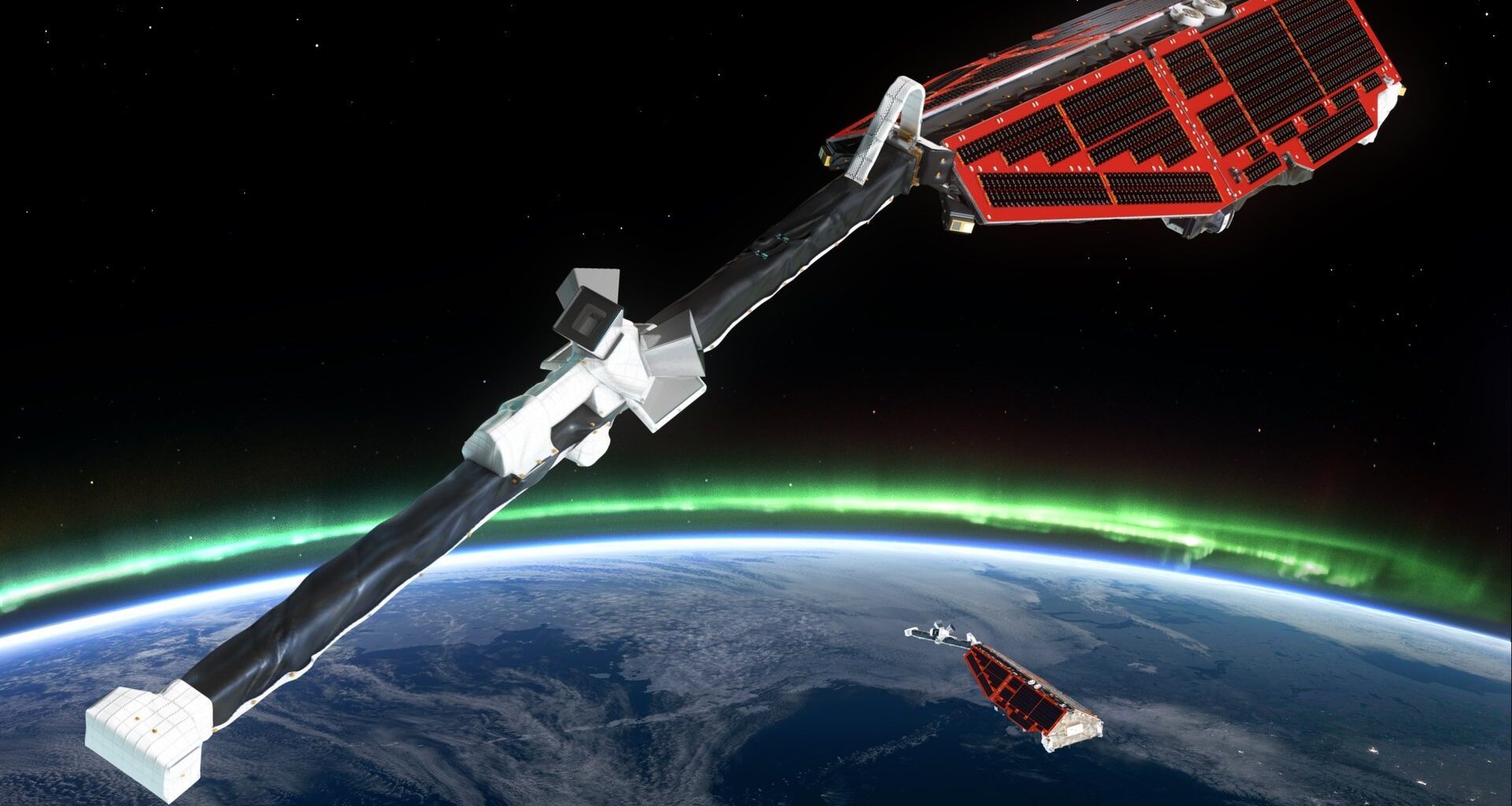*Swarm Sees Key Changes in the Southern Atlantic Anomaly and more. *
Earth is a dynamic place, both on its surface and down to its very core. The European Space Agency (ESA) recently released findings from its Swarm constellation of Earth-observing satellites highlighting this fact, documenting activity in the planet’s magnetic field during its decade plus of extended operations. One key finding shows the well-known Southern Atlantic Anomaly is expanding in size.
The finding was published this month in Physics of the Earth and Planetary Interiors. Not only has the Anomaly expanded over a range the size of continental Europe over the past decade, but the area southwest of Africa has experienced an accelerated weakening since 2020.
First, a caveat is in order. Keep in mind, this expansion of the Southern Magnetic Anomaly is merely a snapshot of a decades worth of activity seen in the Earth’s magnetic field. The SMA has been noted since the late 19th century, but has only been recently studied extensively with Swarm.
Swarm is a trio of satellites (Alpha, Bravo and Charlie) launched from Plesetsk Cosmodrome on November 22nd, 2013. Swarm had an original 4 year nominal mission, and will celebrate 12th full years of operation next month. The trio are in a sun-synchronous low Earth polar orbit. The Canadian Space Agency (CSA) added a fourth satellite Echo to the constellation in 2018. Swarm is a flagship mission for ESA’s FutureEO program.
Swarm’s mission is to study dynamic processes through the Earth’s core, mantle, surface and atmosphere and how they interact, by examining magnetic and electrical conduction.
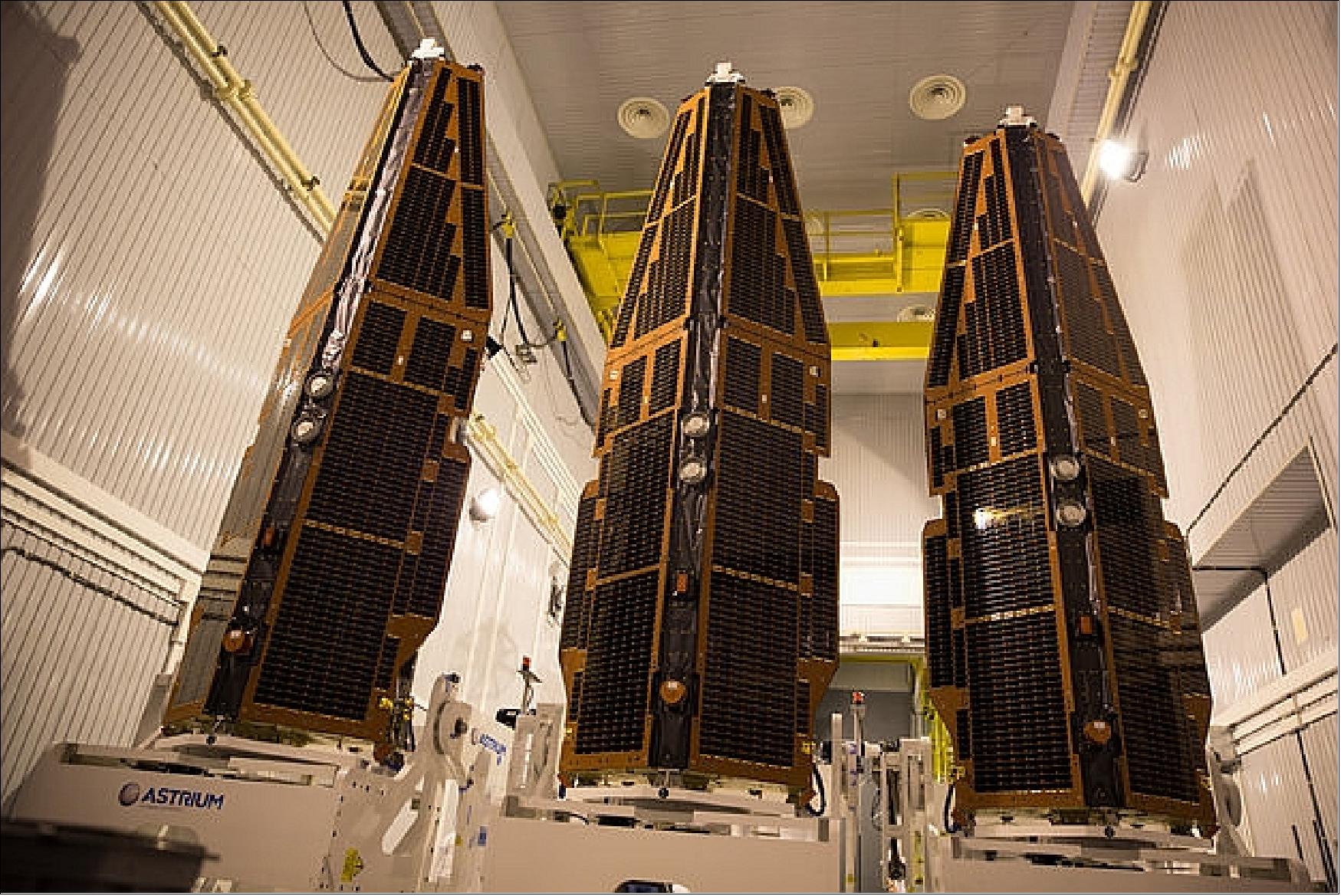 The original Swarm trio of satellites prior to launch. Credit: ESA.
The original Swarm trio of satellites prior to launch. Credit: ESA.
Universe Today recently talked to ESA Swarm Mission Manager Anja Stromme about the findings and the project:
“Because the Swarm mission has flown for more than a decade, we can now see not only detailed magnetic signatures of the many processes it observes, but also some trends and changes. Although 11 (almost 12) years of observations is relatively short in the time frame of Earth core processes, we see that in some regions of the Earth the changes are noticeable.
One of these regions is the South Atlantic Anomaly, where the magnetic field is weakening and the region has expanded since the launch of the Swarm mission in 2013. This shows that the processes in the Earth’s core and the core-mantle boundary are very complex. It is a reminder that the Earth’s magnetic field is not a simple dipole, and that we need to continue to have high quality magnetic measurements from space in order to enhance our understanding of the processes and to improve our geomagnetic models.”
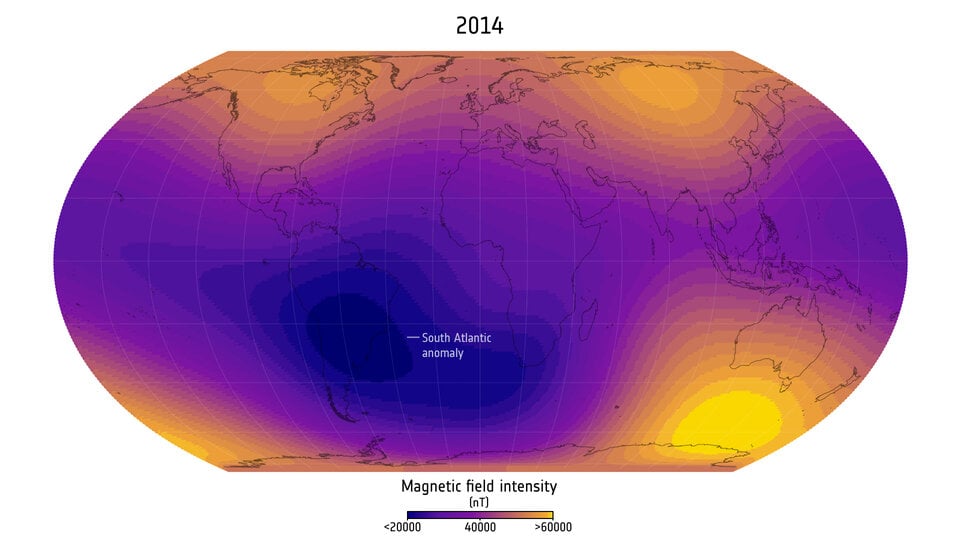 *The South Atlantic Anomaly in 2014. Credit: ESA/Swarm*
*The South Atlantic Anomaly in 2014. Credit: ESA/Swarm*
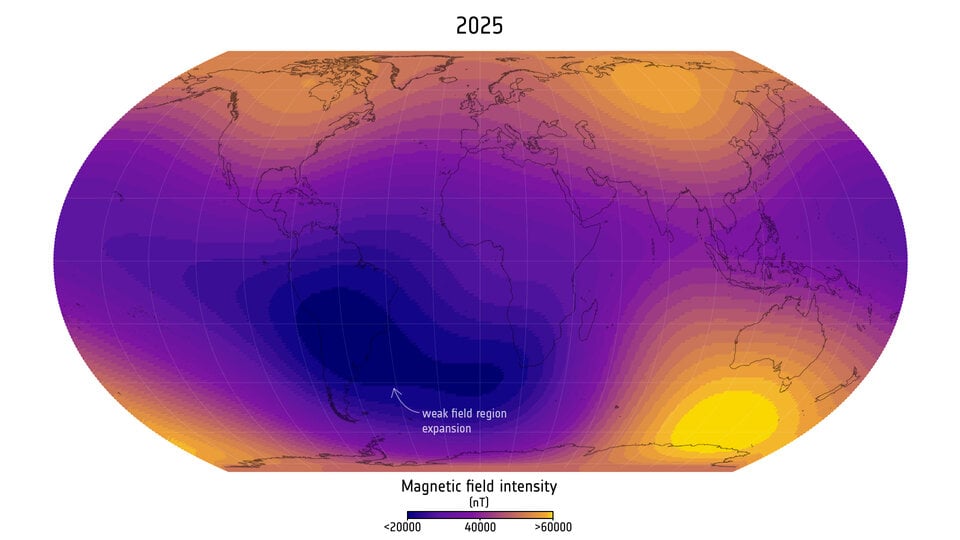 *The South Atlantic Anomaly in 2025. Credit: ESA/Swarm*
*The South Atlantic Anomaly in 2025. Credit: ESA/Swarm*
Understanding the Southern Atlantic Anomaly is crucial, as it impacts satellites. Passing over the weakened patch, satellites experience higher levels of incoming radiation, and are subject to blackouts and hardware failure.
Our planet’s magnetic field is generated by the dynamo of our liquid iron outer core. This protective field is crucial to shielding us from the worst impacts of space weather. But the internal interaction of our planet is a complex one, leading to a global field that is far from homogeneous. Swarm has revealed that interactions between the outer core and the rocky mantle cause ‘reverse flux patches’ which present as strong and weak spots in the planet’s magnetic field.
Not only is the Southern Atlantic Anomaly of key interest, but Swarm has also followed the bizarre tri-polar nature of the strong points in the Earth’s magnetic field. Specifically, the planet has one strong patch in the southern hemisphere, but two in the northern: one over Canada and one over Siberia. Swarm has seen the Canadian patch loose an area about the size of India, but the northern Siberian strong region grow by roughly the size of Greenland.
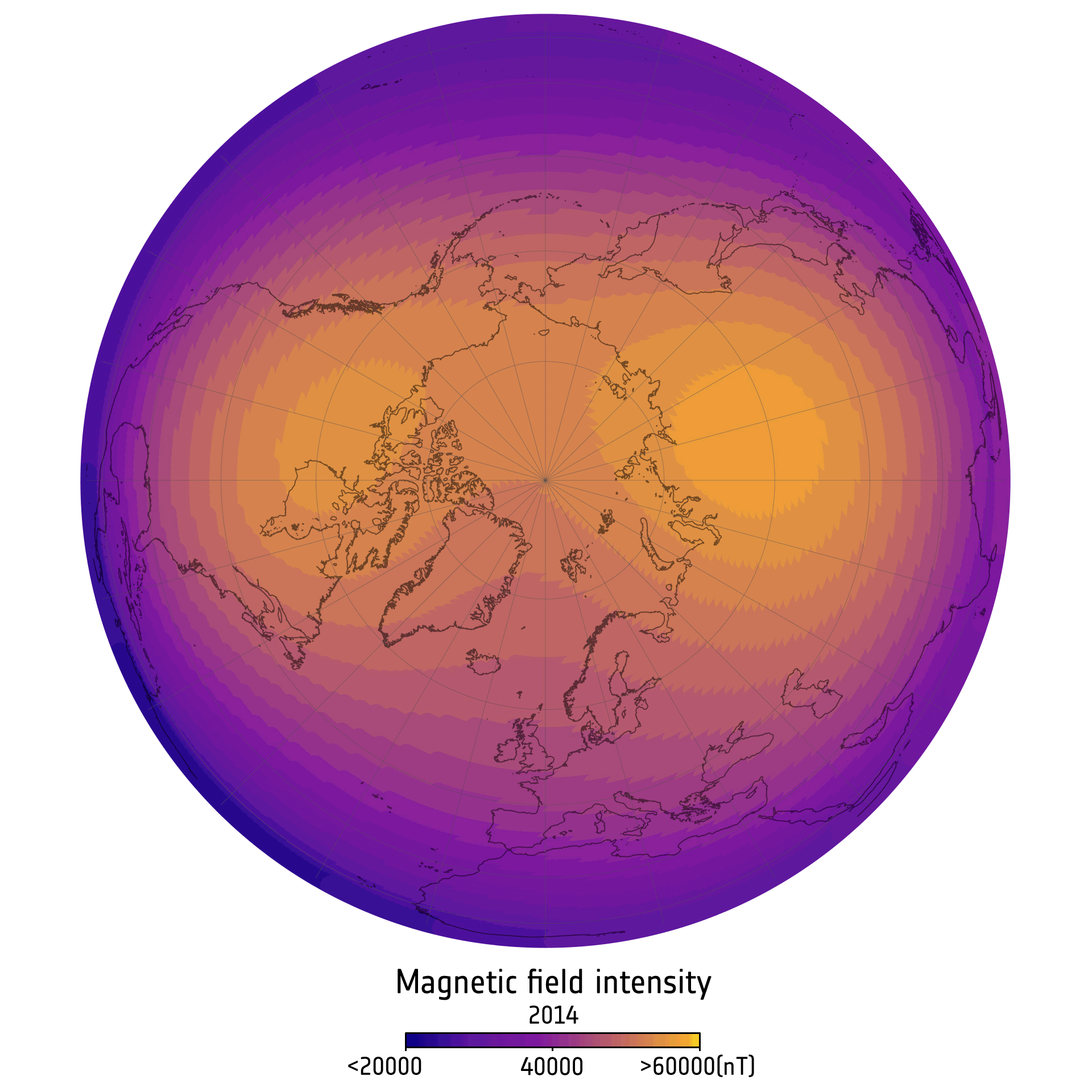 *A comparison of the ‘twin poles’ of Earth’s magnetic field. credit: ESA/Swarm*
*A comparison of the ‘twin poles’ of Earth’s magnetic field. credit: ESA/Swarm*
“The Swarm satellites are unique in being able to provide extremely accurate measurements of the magnetic field in and around our planet,” says Stromme. “To achieve these accurate measurements, the Swarm satellites are designed and equipped in a very specific way. The satellites themselves and all the equipment onboard are selected and designed to produce as little magnetic noise as possible. In addition the magnetometers (the instruments measuring the magnetic field) are placed on a long boom sticking out from the spacecraft to remove them from the magnetic noise there will always be on a spacecraft.
The accuracy of the measurements is needed both in the direction and the magnitude of the signal, and to achieve this we are carrying two magnetometers onboard each satellite. On the middle of the boom, we have a magnetometer measuring three independent vectors of the magnetic field, and this magnetometer is accompanied by a three-headed star tracker using an updated star map to know exactly where we are pointing and hence the direction of the measurements. At the very tip of the boom, we have the second magnetometer the primary purpose of which is to measure the absolute value of the magnetic field extremely accurately and hence to calibrate the vector measurements. This design enables Swarm to provide the most precise measurements of magnetic field and magnetic field variability from orbit. By flying the three satellites in formation, we can resolve the different scales and help separate the different contributions to the overall signal from different processes and regions.”
Not only is the finding a milestone for the Swarm mission, but the documentation represents the longest continuous record of space-based magnetic field measurements. Not only has Swarm witnessed unseen internal activity deep below the surface of the Earth, but the mission seeks to understand how this interacts with the crust, global oceans and right up through the planet’s atmosphere.
“The findings are important for several reasons. On a fundamental level, these they provide insight into the Earth’s magnetic field, an essential property of our planet that makes Earth habitable,” says Stromme. “On a more practical level, the changes we see in the Earth magnetic field are affecting models used for navigation. not only in the South Atlantic Anomaly region but also in the northern polar regions, where the field over Canada is weakening while that over Siberia is strengthening.”
Swarm’s additional list of accomplishments and discoveries is impressive. Swarm pinpointed a direct connection between satellite GPS-blackouts and ionospheric activity in 2016. Swarm also discovered a jet stream-like feature of molten iron moving through the Earth’s outer core.
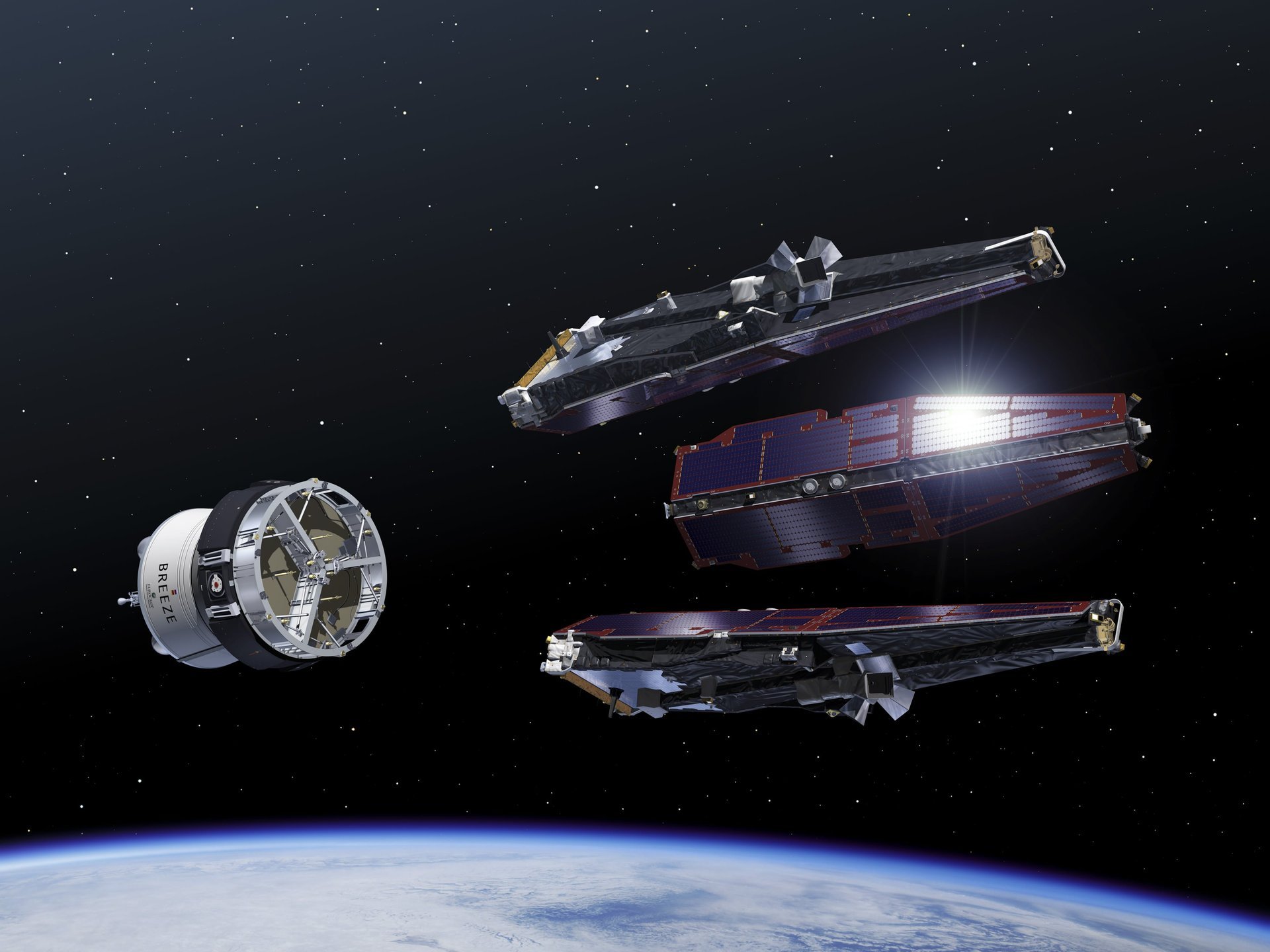 An artist’s concept of the Swarm deployment. Credit: ESA.
An artist’s concept of the Swarm deployment. Credit: ESA.
Swarm was even crucial in helping to confirm the existence of STEVE (a backronym for Strong Thermal Emission Velocity Enhancement), the aurora-related phenomenon first noticed by dedicated amateur astronomers and brought to researchers’ attention in 2017.
“There are plans to extend the Swarm mission for another three years to 2028, if funding is made available,” Stromme told *Universe Today*. “This will allow for further improvements in our understanding and our models of processes from the Earth’s core, mantle, crust and oceans, and of our ionosphere and magnetosphere. We are currently at or slightly beyond the peak of the 11-year solar cycle, a period with enhanced magnetic activity on the Sun resulting in beautiful aurora displays further south on our planet than normal (most of Europe could see auroras during the 11 May 2024 geomagnetic storm).
The Swarm mission can study these exciting but also potential harmful space weather effects around our planet very accurately, and will continue to do so in the years to come, but at the same time these magnetic signals associated with storms on the Sun are disturbing the signals with Earthly origins. By flying Swarm for at least three more years, we will again get a quieter Sun and hence even more accurate measurements of processes inside our planet and across our oceans.
Meanwhile we are developing a new smaller ESA mission called NanoMagSat, a constellation of three smaller spacecrafts that will overlap with at least one of the Swarm satellites. For the even longer-term future, we are in the process of making plans for how we can ensure continuous high-quality magnetic measurements from space.”
Researchers hope to keep the Swarm mission going until into the next decade. It’s a remarkable mission, and Swarm has revealed that the inner space below our feet is also an equally fascinating place, worthy of further study.

